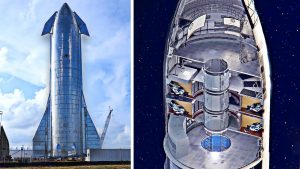SpaceX Starship Is Revolutionising Space Travel
 SpaceX’s Starship represents the next giant leap in space exploration. The spacecraft, designed for both crewed and uncrewed missions, aims to transform how humanity travels in space. Unlike previous spacecraft, Starship is intended to be fully reusable, significantly reducing the cost of space travel. Its capabilities go beyond Earth’s orbit, making it a key element in SpaceX’s long-term goal of interplanetary exploration.
SpaceX’s Starship represents the next giant leap in space exploration. The spacecraft, designed for both crewed and uncrewed missions, aims to transform how humanity travels in space. Unlike previous spacecraft, Starship is intended to be fully reusable, significantly reducing the cost of space travel. Its capabilities go beyond Earth’s orbit, making it a key element in SpaceX’s long-term goal of interplanetary exploration.
Vision behind Starship
Starship’s development is driven by SpaceX’s vision to make space travel more accessible and sustainable. Elon Musk has repeatedly stated his desire to use Starship for human colonization of Mars. The spacecraft is designed to carry large crews and cargo to destinations across the solar system. With the ability to land on planets and moons, SpaceX Starship could pave the way for human settlement on distant worlds.
SpaceX envisions Starship as the vehicle that will not only reach the Moon and Mars but also enable commercial space tourism and cargo deliveries to various orbits. Its reusable design makes it uniquely suited to revolutionize space exploration. As SpaceX continues to refine Starship, the craft is expected to change the way people think about space travel and its future.
Design and structure of Starship
Starship’s design is highly innovative, with a focus on efficiency and reusability. The spacecraft is made from stainless steel, a material known for its durability and strength. Stainless steel also provides superior heat resistance, crucial for reentry into Earth’s atmosphere. The spacecraft consists of two parts: the Super Heavy booster and the Starship spacecraft itself. Together, these components form a fully reusable space transportation system.
The Super Heavy booster is designed to lift Starship into orbit before it detaches and returns to Earth. The Starship spacecraft, on the other hand, is intended for long-duration missions and is capable of carrying both passengers and cargo. SpaceX has focused heavily on ensuring that Starship is not only powerful but also cost-effective, relying on its reusability to make space travel more affordable.
Reusability
The most groundbreaking feature of Starship is its reusability. SpaceX aims to dramatically reduce the cost of space travel by designing a spacecraft that can be launched, landed, and reused multiple times. The ability to reuse both the booster and the spacecraft itself sets Starship apart from other space missions, which rely on single-use rockets and capsules.
This reusability will allow SpaceX to dramatically increase the frequency of space missions. Frequent launches mean that SpaceX can offer lower-priced services, opening up new markets for satellite deployments, cargo transport, and even human space tourism. By creating a sustainable system for space travel, SpaceX hopes to make interplanetary travel a reality for future generations.
Starship’s role in space exploration
Starship is poised to play a central role in the future of space exploration. It is being developed for deep-space missions, with Mars being a primary target. The spacecraft will be capable of carrying large crews and significant amounts of cargo on long-duration flights. This capacity makes Starship the ideal candidate for missions to other planets, including the Moon, where NASA has planned to send astronauts under its Artemis program.
Beyond Mars, Starship could also be used for missions to the outer planets, such as Jupiter and Saturn, where its long-range capabilities would be put to use. The spacecraft’s reusability makes it ideal for these kinds of missions, reducing the need for new rockets for every mission. This will allow SpaceX to explore more distant regions of our solar system with greater frequency.
Starship launch system
The Starship launch system is made up of two parts: the Super Heavy booster and the Starship spacecraft. The Super Heavy booster is responsible for providing the initial thrust required to propel the spacecraft into space. After launch, it detaches and returns to Earth for refurbishment and reuse. The Starship spacecraft, once in orbit, can continue its journey to various destinations in space.
Both the Super Heavy booster and the Starship spacecraft are designed for quick turnaround times, allowing them to be launched again with minimal refurbishment. The goal is to make the launch process as streamlined and cost-effective as possible. This system of reusability is key to SpaceX’s mission of reducing space travel costs and making frequent launches a reality.
Raptor
A major technological breakthrough for Starship is the development of the Raptor engine. This next-generation rocket engine uses liquid methane and liquid oxygen, which are more efficient and environmentally friendly compared to traditional rocket fuels. The Raptor engine is designed to be highly reusable, with minimal wear and tear after each launch.
The Raptor engine also provides Starship with significant thrust, allowing it to carry heavy payloads to space. This capability is crucial for long-duration missions that require significant amounts of fuel and supplies. As SpaceX continues to refine the Raptor engine, it is expected to play a central role in making Starship a powerful tool for interplanetary exploration.
Starlink project
In addition to its space exploration goals, Starship will play a crucial role in supporting SpaceX’s Starlink project. Starlink is a satellite internet initiative aimed at providing global internet coverage. SpaceX has already launched thousands of satellites into low Earth orbit, but Starship will be used to launch many more satellites in the coming years.
With its large payload capacity, Starship can carry hundreds of Starlink satellites in a single mission. This ability to deploy satellites at an accelerated pace will help SpaceX achieve its goal of providing fast, reliable internet to underserved regions of the world. As Starlink continues to grow, Starship will be essential in expanding the satellite constellation and maintaining a robust, global network.
Potential for space tourism
In addition to its role in space exploration and satellite deployment, Starship also has the potential to revolutionize space tourism. SpaceX has already made waves with its Crew Dragon spacecraft, which carried astronauts to the International Space Station. Starship, however, takes space tourism to the next level by offering the possibility of long-duration, interplanetary travel.
The spacious interior of Starship is designed to accommodate passengers on extended trips, with ample room for sleeping, dining, and recreation. The potential for human missions to the Moon, Mars, and beyond offers a once-in-a-lifetime opportunity for space tourists. As the development of Starship progresses, it’s likely that more individuals will have the opportunity to experience space travel.
Partnership with NASA
SpaceX has formed a strong partnership with NASA, particularly in its efforts to develop Starship. NASA has awarded SpaceX contracts for lunar lander development as part of the Artemis program. Starship will serve as a key component in NASA’s plans to return astronauts to the Moon, and it will be used to transport astronauts between lunar orbit and the Moon’s surface.
This collaboration highlights the growing importance of Starship in both private and governmental space missions. NASA’s reliance on SpaceX for future missions underscores the spacecraft’s versatility and capabilities. It’s clear that Starship will play a significant role in humanity’s return to the Moon and the eventual journey to Mars.
Testing and development
The development of Starship is an ongoing process, with regular tests and refinements being made to the spacecraft and its systems. SpaceX has conducted numerous static fire tests, launch tests, and landings to validate the spacecraft’s design and functionality. Each test provides valuable data that helps improve the spacecraft’s performance and reliability.
Starship’s development is a dynamic process, with SpaceX constantly pushing the boundaries of what is possible in space travel. The company’s rapid prototyping and testing approach has enabled it to make significant progress in a short amount of time. As the spacecraft continues to evolve, SpaceX will undoubtedly encounter new challenges, but its ability to adapt and innovate will be key to its success.
Future of Starship
Starship’s future is incredibly promising, with the spacecraft poised to change the landscape of space exploration. With its reusability, massive payload capacity, and long-range capabilities, Starship will likely be the vehicle of choice for many space missions in the coming decades. Whether carrying astronauts to the Moon, deploying satellites for Starlink, or facilitating space tourism, Starship has the potential to reshape how humanity explores space.
As SpaceX continues to refine and test Starship, the spacecraft’s capabilities will only grow. The company’s long-term vision for Starship includes human missions to Mars and the potential for interstellar exploration. SpaceX’s commitment to making space travel more sustainable and accessible ensures that Starship will play a key role in humanity’s future in space.
New era of space exploration
Starship marks the beginning of a new era in space exploration. With its advanced design, reusability, and ability to carry both passengers and cargo to distant destinations, Starship is poised to be the spacecraft of the future. Its development will redefine how we travel to space, opening up new possibilities for exploration and commercial ventures. SpaceX’s commitment to innovation and sustainability ensures that Starship will be a central part of humanity’s journey into the cosmos.










